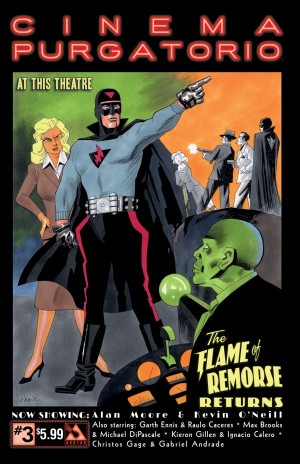
Annotations for “The Flame of Remorse Returns” 8 pages in Cinema Purgatorio #3
Writer: Alan Moore, Artist: Kevin O’Neill
>Go to overall Cinema Purgatorio annotations index
>Go to Moore-O’Neill Cinema Purgatorio stories annotations index
Note: Some of this is obvious, but you never know who’s reading and what their exposure is. If there’s anything we missed or got wrong, let us know in comments.
General: The unnamed protagonist watches “The Flame of Remorse Returns” a time-twisting serial episode.
Cover – no specific annotations
Page 1
panel 1
- This is the first showing of entirety of the words “Cinema Purgatorio.”
- ” 3′- ” (actually “3/-“) is three shillings, about 15p (or roughly 10 U.S. cents) in today’s money.
- Panelwise, the framing sequence gutters have gradually straightened out since their initial curvy appearance in issue #1.
panel 2
- The ticket frames the woman’s eye on the right.
panel 3
- “Roy Flicker” apparently refer to “flickers” a common slang term for older movies.
- “The Glory That Was Rome” was apparently the name of the unnamed epic film in Cinema Purgatorio #2. There was a The phrase comes from a version Edgar Allan Poe’s poem “To Helen” which includes:
To the glory that was Greece,
And the grandeur that was Rome.
- (For what it’s worth, the phrase “The Glory that was Rome” appeared as the title of a 1927 British Pathé newsreel, though this is probably not what Moore and O’Neill are referencing.)
panel 5
- “Eternal Pictures” with the heavenly gates continues a theme of the protagonist being dead – see issue #2 P8,p4-5.
- “Colourless” seems like a play on the black and white printing of Cinema Purgatorio.
Page 2
panel 1
- A “serial” is a type of short ongoing cliffhanger film popular in the early 20th Century. Moore and O”Neill traffic in familiar serial characters: hero, heroine, villain, and henchmen.
In some way serials parallel the relatively-immature comics of the 1930s through the 1960s (and, frankly, even to today.) The stories are shallow, formulaic, full of fist-fighting, and the cliffhanger endings are “to be continued.”
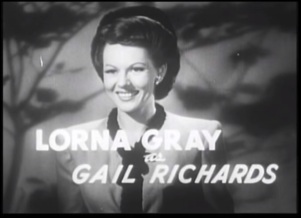
panel 2
- The credits are a standard movie trope, typical for serials, too.
- Commenter Paul Mark Evans points out that the hero’s actor is not named, which was also done in the Superman serial.
- “Kay Terry” may refer to actress Sheila Terry whose who was born Kay Clark.
- “Joe Casey” is, perhaps unrelatedly, the name of a comics writer.
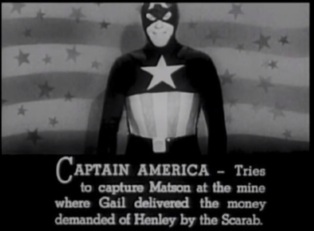
panel 3
- Each serial episode includes text recapping the dynamics of the cliffhanger ending of the prior episode. (Comics do a lot of this.)
- “Vanish gun” is an example of a serial trope where nefarious inventors create fictitious science weapons.
panels 4-5
- After the text recap, serials show a brief excerpt repeating a minute or so of the actions leading into the cliffhanger ending. These two panels were likely part of prior episode.
panel 8
- “I’d thought we were higher up than that” points out the movie’s continuity error. Somewhat typically characters escape the cliffhanger through conditions not revealed in the earlier episode, though it is rarely as blatant as this.
- “Eason’s” may be a nod to (critique of) the Irish stationery and book retailer. Commenter Paul Mark Evans thinks it may be short for “Season’s”.
Page 3
panel 1
- “The Flame of Remorse can never be extinguished” sounds like a repeated catchphrase, similar to “Who knows what evil lurks in the hearts of men? The Shadow knows.”
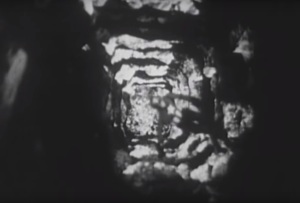
panel 2
- “Secret mineshaft” is a common serial villain hideout trope.
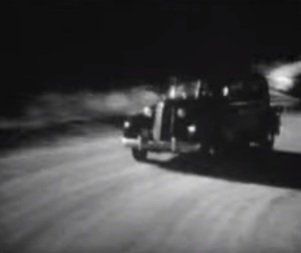
panel 4
- The Flame’s car resembles a black Packard. According to Wikipedia:
[Studios making serials] saved money by reusing the same cliffhangers, stunt and special effect sequences over the years. …The same model cars and trains went off the same cliffs and bridges. Republic had a Packard limousine and a Ford Woodie station wagon used in serial after serial so they could match the shots with the stock footage from the model or previous stunt driving.
- One example of the oft-appearing Packard is King of the Rocketmen, part 1 (a serial that inspired Dave Stevens’ Rocketeer comics.)
panels 7-8
- The car chase (on a winding mountain road) is another serial film trope. One example is in King of the Rocketmen, part 2 (starting at 10:45.)
Page 4
panel 1
- A car, especially a Packard, going off a cliff is another serial film trope. One example is in King of the Rocketmen, part 1 (starting at 2:55.)
panel 4
- This panel repeats P3,p8 exactly. This repetition alludes to studio production practices that saved money by including the same footage in multiple series. Serial scene repetition also occurs to recap a character’s escape from a cliffhanger ending.
Moore and O’Neill are playing with serial movie scene repetition as a superpower to consciously “expand time” (which is essentially what the studios were doing by repeating footage.)
Moore played with a somewhat analogous “nested time” (including repeated scenes) in Providence #5 and #6.
panel 5
- Showing the hero escaping is a very common trope shown at the beginning of a serial episode. The escape scene is omitted in the end of the earlier episode (in this case P3,p8 through P4,p2 above) then at the beginning of the next episode the scene is repeated with additional footage showing how the hero escapes what appeared to be certain death.
panel 7
- This panel repeats p1 above – again referencing how serials repeat footage.
Page 5
panel 3
- These criminals are expressing their remorse – apparently this is caused by the Flame of Remorse.
panel 8
- This panel echoes the layout and some dialogue from p3 above, indicating the story is in another time loop.
Page 6
panel 1
- The panel repeats the two central figures and the rest of the dialogue from P5,p3 above.
panel 2
- The dialogue repeats from P5,p4 above.
panels 3-5
- These repeat Page 5, panels 5-7 above – again referencing how serials repeat footage.
Page 7
panel 1
- The villain Casey is again expressing remorse.
panel 2
- “Unforgivable sins” echoes a theme of death and purgatory. See P1,p5 above.
panel 3
- “There’s no way out” describes both the villains plight and the apparent inescapable nature of the heroes’ apparent cliffhanger deaths.
- This depicts a somewhat over-the-top but still typical serial cliffhanger ending.
- “Th-that’s disturbing…” is unnamed narrator’s thoughts.
panel 4
- “The idea of someone following you…” is the unnamed narrator sympathizing with the serial villain. This is unusual as the viewer typically identifies with the hero.
panels 4-8
- These are previews – another example of studios repeatedly using the same footage.
Page 8
panel 1
- Flight of the Bumblebee is rapidly-paced piece of classical music, written by Nikolai Rimsky-Korsakov. Commenter Paul Mark Evans points out that it was the theme music for The Green Hornet serial.
panel 2
- “It… colours the whole atmosphere” contrasts with the black and white of serial films and of Purgatorio printing.
panel 4
- It is not entirely clear, but the so-far unnamed and undepicted narrator is apparently female. This appears to be her hand (with an apparent wedding ring) opening the door to the ladies bathroom.
- The bucket and mop bleach are shown here are minor recurring element, and symbolize of purgatory purification. Bleach, broom and scrub brush appear in CP15 P1,p1. The mop appears again in CP16,P8,p4. The mop, bucket and bleach return in the final crime scene cleaning frame in CP18 P3,p7. (Thanks to FMB for noting this.)
- Perhaps the flooded floor of the bathroom alludes to the River Styx.
panel 5
- “Serve your sentence” alludes to purgatory, where sinning souls suffer before going to heaven
>Go to Purgatorio Annotations Index
>Go to Cinema Purgatorio #3 index
>Go to Cinema Purgatorio #4 index
>Go to Cinema Purgatorio #4 Moore and O’Neill annotations
As far as I recall, Moore has said that the narrator is female, in interviews with Bleeding Cool.
LikeLike
hmmm… “the story of one woman forced to bare her soul, one short film at a time” from the blurb here.
LikeLike
Okay, bout time we had a proper discussion of this…
First of all, I think she’s in some sort of Purgatory, or some expression of Purgatory. Maybe she doesn’t remember who she is, she’s said nothing about herself. Everyone in the last 2 films seems to be in some sort of horrible suffering over existential issues. Anyway…
The ticket taker “You’ll appreciate that for adults and children there are different…” I think this might be the Catholic concept of limbo, perhaps, where unbaptised children go and hang around de-personalised forever. Which is nice. Where adults, who aren’t bad enough to go to Hell, get to go to Purgatory to burn off their sins. The cinema seems more like an existential view of that, a more detached, less personal god than the Christian one, even if the basic idea is nicked from there.
“Flickers” isn’t a word for “cinema”, that’s “flicks”. “Flickers” sounds a bit like a mis-hearing of “Hitler” though, cos unless Blakey off On The Buses was a worse bloke than we thought, that moustache is pretty uniquely identifying. “Roy” I dunno. Maybe Hitler doesn’t remember his old life either, or maybe divine authorities have given him the job cos it’s something he knows a bit about.
“Almost like a church, but fallen”, you see in that frame, people on a higher level, leading through an “Exit”. Maybe they’ve finally suffered enough of these weird films and are allowed to go on to heaven. “Disrepair and obscurity”, because Christianity in the West used to be a foundation of society, now it’s something most people don’t bother with. Certainly in the UK. So maybe Purgatory has had it’s budget cut.
The usherette, maybe Asmodeus, the lame demon? No reason why apart from the leg brace.
The film itself, which was fantastic! The bit with the building The Flame falls off suddenly losing most of it’s height isn’t a mistake, that’s him using his power. Dita Larue’s lines to Joe Casey are dissociated and horrible! Sort of thing Alan and Kevin do very, very well. “You’re all embryonic corpses”! That alone worth the price of admission.
The villains’ increasing sense of unease, of things not being right, follows on from the Roman epic previously. The way they break down, because forces beyond their control are punishing them, and they know they deserve it! The regret, the horror. Bloody brilliant!
“An Eternal serial”, and I bet it probably is. Poor Joe Casey carries on suffering forever! An infinite series of films, where things get worse and worse yet it never ends.
Anyway that’s my thoughts for now. Bloody good comic! Alan hasn’t done anything so weird and disconcerting in years! All that time he spent writing stupid puns and channelling Harvey Kurtzman for Tomorrow Stories, when he could’ve been writing meisterwerk like this! I love Purgatorio.
Still not figured out what was going on in The Fatal Officers. Were the Officers other penitents, or were they unstoppable divine punishment? Who can know?
Wouldn’t really care if all the backup stories in the comic disappeared, though I’m still enjoying most of them, Cinema is miles ahead, it’s just something else. Can’t wait to find out what it all means in the end.
LikeLiked by 1 person
I thought the fatal officers were a comment on the establishment (this has probably been pointed out previously). The accountability and cack-handedness of the police and other pillars of society. cover-ups and smears, like Fatty Arbuckle’s, and if you question it you get weaved into the tapestry.
LikeLike
Oh, and I think you’re on a road to nowhere with the actors’ names. Pretty sure they’re just made up.
LikeLiked by 1 person
Wow, what a clever story!
I like the increasing implausibility of the heroes surviving each cliffhanger, culminating in actually seeing them stabbed to death (and a preview of the “next” episode’s cliffhanger – the heroine’s head no longer attached).
I would guess that Alan Moore has no idea who Joe Casey the comics writer is, but it’s a funny coincidence because Joe Casey has written a lot of big never-ending mainstream comics like Superman and X-Men, which are very analogous to these old serials.
I agree the “Eternal Pictures” logo on page 1, panel 5 is a reference to the overall purgatory-like setting, but it could also be a pun on the unending (or “eternal”) nature of serials themselves.
LikeLike
Some thoughts regarding details on Page 8:
In panel 1 there’s a silhouette of a man and a woman in a seemingly loving embrace which is ambiguous enough to also represent an assault or strangulation in process, echoing the comic’s underlying sense of threat in regular settings.
This may be obvious, but the poster in panel 3 – ‘Gotta Sing Sing’ is an allusion to both musicals and the New York prison. Since this issue also features a poster for ‘The Glory that was Rome’, this may mean we’ll have an Alan Moore “women in prison” parody coming in the future, along with ‘The Crawling Heart’ that appeared in issue 2.
Panel 4 features a toilet-paper dispenser with an ‘Acme’ logo, a nod to the fictional company in the Roadrunner cartoons.
Finally, in the final panel the sink-hole of the basin seems to be in the shape of an eyeball, perhaps symbolizing some sort of eternal presence watching the main character (or possibly also doubling for the eye of the reader).
LikeLike
This story has been stuck in my head for the last 24 hours like a song on repeat, and I realized that it reminded of a scene from Stephen King’s Misery:
After watching it again just now, I can’t believe how on-the-nose it is in regards to “The Flame of Remorse Returns” (Rocketman in a car going off a cliff, even!).
The difference is that King is just complaining about/mocking the serial cliffhangers’ logical fallacy, while Moore and O’Neill have provided a horrifying, yet comical, explanation for how it could actually make sense within the story.
LikeLiked by 1 person
FLICKER is the title of a book by Theodore Roszak which features, amongst other things, a secret cult called THE CHILDREN OF THE STORM, which is the name Alan Moore and Mitch Jenkins use for the production company that made the series of short films called SHOW PIECES.
Pádraig
LikeLike
Actually it’s “Orphans Of The Storm”, dunno if that’s a reference to anything. Maybe he liked “Flicker” and made a change.
LikeLike
Be nice to see what our unnamed narratress makes of “Jimmy’s End” in issue 6.
LikeLike
(From page 3, panel 4): Actually, the Flame’s car seems to be a 1937 Cord 812.
LikeLike
“Flight of the Bumblebee” was used as the theme of the Green Hornet serials. The name of the actor playing the hero is not revealed, as with the Superman serials. I assumed that “EASON’S” was truncated from “SEASON’S” or some other word.
LikeLike
Good stuff! Added.
LikeLike